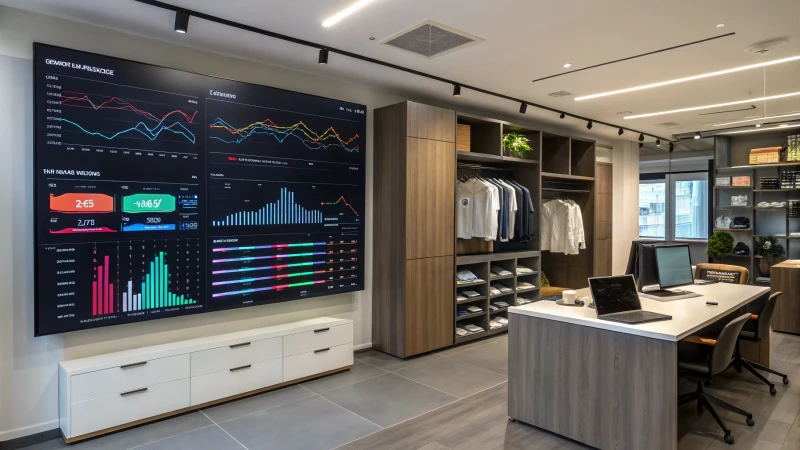
Ever wondered how predictive analytics can transform the way we manage underwear inventory?
Predictive analytics revolutionizes underwear inventory management by forecasting demand with precision, optimizing stock levels, and cutting down on waste. By diving into sales data and market trends, businesses can anticipate needs, preventing both stockouts and surplus.
I remember the first time I encountered a stockout issue—frustrating! It felt like I was letting down my customers, and it was a wake-up call to find a better solution. That's when I discovered predictive analytics. This technology not only helps predict what items will fly off the shelves but also adapts to ever-changing trends. Imagine knowing exactly which colors or styles are going to be the next big thing! It's like having a crystal ball for your inventory. And it's not just about avoiding empty shelves; it's about freeing up cash flow by not overstocking on items that might not sell. It's a game-changer, turning inventory management into a proactive rather than reactive process. With predictive analytics, I’ve learned to navigate the complexities of consumer demands with ease and confidence.
Predictive analytics reduces underwear stockouts by 30%.False
While predictive analytics can reduce stockouts, the exact percentage varies.
Sales data analysis helps forecast underwear demand accurately.True
Analyzing sales data allows businesses to predict demand trends effectively.
How Does Historical Sales Data Influence Predictive Analytics?
Have you ever wondered how businesses seem to predict exactly what you'll need before you even know it? It's all thanks to historical sales data.
Historical sales data is crucial for predictive analytics, as it reveals trends and patterns that help businesses forecast demand, manage inventory, and refine marketing strategies. By analyzing past sales, companies can anticipate future needs and make informed decisions.

Understanding Historical Sales Data
I remember the first time I realized the power of historical sales data. It was like finding a map to a hidden treasure. These records of past transactions—what was sold, how much, at what price, and when—are more than just numbers. They're stories of success, missed opportunities, and consumer behavior that are waiting to be uncovered. Analyzing this wealth of information1, businesses can uncover patterns that are crucial in predicting what comes next.
Trend Analysis and Forecasting
Trend analysis felt like my own personal crystal ball. By spotting sales patterns across various times—whether daily, monthly, or seasonally—I could forecast future demands with surprising accuracy. Picture this: after a detailed trend analysis2, you find that cozy sweaters fly off the shelves every November. Suddenly, you're prepared for the seasonal rush, keeping your inventory perfectly stocked.
Inventory Optimization
Let me tell you about a time when predictive analytics saved me from a warehouse full of unsold umbrellas during a drought. By predicting demand fluctuations using historical data, I managed to optimize inventory, avoiding overstocking and embarrassing stockouts. This kind of inventory management3 turned out to be a game-changer.
| Key Metric | Benefit |
|---|---|
| Demand Forecasting | Reduces excess inventory |
| Sales Pattern Analysis | Prevents stockouts |
Tailored Marketing Strategies
Imagine crafting marketing strategies that feel like they were designed specifically for your customers. Historical sales data lets you peek into consumer preferences and buying behaviors, enabling you to create campaigns that truly resonate. Crafting marketing strategies4 grounded in past consumer actions can turn potential into profit.
Identifying Anomalies
Every now and then, data throws us a curveball—anomalies that signal hidden issues or unexpected opportunities. Predictive analytics shines a spotlight on these irregularities, giving us a chance to address them before they become problems. It's like having a sixth sense about your business operations; understanding these anomalies5 can refine decision-making processes.
By using historical sales data as our compass, predictive analytics becomes a formidable ally in enhancing operational efficiency and strategic decision-making. Whether it's forecasting demand or refining marketing strategies, this approach keeps us a step ahead in the competitive business landscape.
Historical sales data is crucial for trend analysis.True
Trend analysis relies on past sales data to predict future patterns.
Predictive analytics can function without historical sales data.False
Historical data is essential for building predictive models and insights.
How Do Seasonal Trends Affect Underwear Inventory Forecasting?
Ever wondered why your favorite underwear styles disappear during certain seasons? Understanding seasonal trends can help retailers keep the right stock all year round.
Seasonal trends impact underwear inventory forecasting by affecting demand based on weather, fashion cycles, and promotions. Accurate forecasting helps balance stock levels to prevent overstocking or stockouts.

The Impact of Weather and Temperature Changes
I remember the first time I noticed my thermal underwear flying off the shelves as winter approached. It was like everyone suddenly remembered how cold it gets! Seasonal changes, especially the shift from warm to cold months, dramatically affect what customers look for in underwear. In the chill of winter, cozy thermal pieces become essentials, while in the heat of summer, lighter fabrics take center stage. By diving into historical sales data6, I can predict these shifts and ensure I have just the right amount of stock.
Fashion Cycles and Trends
Fashion is a fickle friend, isn’t it? I’ve seen trends from fashion shows influence what’s "in" for underwear, seemingly overnight. One season, lace is all the rage; the next, it's all about sleek, minimalist designs. Keeping up with these fashion cycles7 is crucial. I’ve learned that if I don’t anticipate these changes, I end up with a lot of unsold stock—and that’s never fun!
| Season | Common Underwear Trends |
|---|---|
| Winter | Thermal wear, dark colors |
| Summer | Light fabrics, bright colors |
| Spring/Fall | Transitional pieces |
Promotional Events and Holidays
Oh, the rush of holiday promotions! Valentine’s Day is particularly memorable for me; it's a time when certain styles become hot commodities. By tracking sales patterns during these promotional periods, I can plan effectively to ensure there's plenty of stock available for those last-minute shoppers. It’s all about effective planning8 to catch those demand spikes without running dry.
Analyzing Customer Behavior
I love getting into the nitty-gritty of customer behavior. With predictive analytics, I can peer into past purchase patterns and see what's likely to happen next. This isn’t just about guessing—it’s about using data to make informed decisions. For instance, if I notice some items are slow-moving, I’ll plan timely discounts to clear them out before new trends take over. This kind of proactive approach helps keep my supply chain9 running smoothly and efficiently.
Thermal underwear sales increase in winter months.True
Colder weather boosts demand for thermal wear as people seek warmth.
Bright colors are unpopular in summer underwear trends.False
Summer trends favor bright colors due to their light and vibrant appeal.
How Can Predictive Analytics Identify Slow-Moving Products?
Ever wondered how some shops seem to know just what you need before you do? That's the magic of predictive analytics at work.
Absolutely, predictive analytics can spotlight slow-moving products by crunching historical sales data and customer trends to predict future demand, helping businesses streamline their inventory.

Understanding Predictive Analytics
The first time I stumbled upon predictive analytics, it felt like discovering a crystal ball for business. Imagine having a tool that uses the wizardry of statistical algorithms and machine learning to peek into future outcomes based on what's happening now and what's happened before. That's exactly what predictive analytics does. In the retail world, it's a game-changer, letting businesses foresee demand and fine-tune their inventory strategies.
How It Works
Let's break it down with a little story. Picture me sitting in front of my laptop, poring over historical sales data10. I'm no math whiz, but these analytics models reveal patterns that were invisible to my naked eye—showing me which products are perpetual shelf-sitters. By pooling data from all sorts of sources, I uncover why some items seem to gather dust longer than others.
Tools and Techniques
It's like having a toolkit full of shiny gadgets: machine learning algorithms and data visualization platforms are my go-tos for making sense of complex datasets. These tools create models that help predict product performance like a seasoned fortune teller.
| Tool/Technique | Description |
|---|---|
| Machine Learning | Uses algorithms to learn from data patterns |
| Data Visualization | Presents data insights in an understandable form |
Application in Retail
In the real world of retail, applying predictive analytics feels a bit like having a secret weapon. I can craft strategies for those sluggish products—maybe it's a flash sale or a strategic price drop based on my newfound insights. And that’s not all; by following a data-driven approach11, I can adjust marketing tactics to match the predicted demand trends, moving that excess stock like never before.
Benefits of Identifying Slow-Moving Products
Spotting these slow-movers early is like finding hidden treasure. It means I can cut down on excess inventory, free up capital, and boost cash flow. Plus, it helps in making smarter purchasing decisions, which ultimately makes my supply chain more nimble and agile.
Predictive analytics can predict product demand.True
Predictive analytics uses data to forecast future product demand trends.
Data visualization hinders understanding of sales trends.False
Data visualization clarifies complex data, aiding in trend analysis.
What Are the Cost Benefits of Using Predictive Models in Inventory Management?
Imagine having the power to predict exactly what inventory you need, saving money and reducing waste.
Predictive models in inventory management offer cost benefits by accurately forecasting demand, reducing overstock and stockouts, and optimizing inventory levels. These models utilize historical data to improve decision-making, streamline operations, and enhance profitability.
%[A warehouse manager analyzing data on a tablet amidst organized shelves](https://xiweiundies.com/wp-content/uploads/2024/12/manufacturing-facility-audit-inspection.webp"Warehouse Manager Analytics")
Understanding Predictive Models
The first time I dove into predictive models, it felt like unlocking a secret treasure chest of insights. These models tap into historical sales data, customer habits, and seasonal trends12, painting a clear picture of future demand. This clarity helps businesses like mine adjust their ordering processes13 before inventory issues arise.
Reducing Overstock and Stockouts
I remember the struggle of shelves filled with unsold goods, leading to increased storage costs. Predictive models changed the game for me. They ensure I stock just the right amount—no more, no less. It’s like having a crystal ball that tells you what’s in demand, so you're not left scrambling or overloading your storage space.
| Benefit | Description |
|---|---|
| Reduced Costs | Less money tied up in unsold stock |
| Improved Cash Flow | More efficient use of capital resources |
Optimizing Inventory Levels
Using predictive analytics, I've learned to maintain just the right balance in my inventory. It's as if I'm conducting an orchestra where each instrument plays in perfect harmony with demand. This equilibrium prevents my capital from getting stuck in unsold products, allowing my cash flow14 to breathe.
Enhancing Efficiency and Profitability
With predictive models, operations become a well-oiled machine. They offer actionable insights into inventory trends, guiding me towards smarter decisions that boost profitability. Implementing these models has made my business nimble, ready to adapt to market shifts and consumer demands swiftly.
Investing in predictive analytics isn't just about cutting costs; it's about setting a foundation for substantial long-term savings15 and operational efficiencies. It's like turning on a light in a room that was once dark—suddenly, you see all the opportunities waiting to be seized.
Predictive models reduce inventory holding costs.True
By accurately forecasting demand, businesses maintain optimal stock levels.
Predictive models guarantee zero stockouts in inventory management.False
While they reduce stockouts, unpredictable factors can still cause shortages.
Conclusion
Predictive analytics enhances underwear inventory management by accurately forecasting demand, optimizing stock levels, and reducing waste through analysis of historical sales data and consumer behavior.
Explore why historical sales data is crucial for identifying trends and making informed business decisions. ↩
Learn how analyzing past sales trends can enhance the accuracy of future demand forecasts. ↩
Discover strategies to optimize inventory levels using historical sales insights. ↩
Find out how historical sales data can guide the development of targeted marketing efforts. ↩
Identify typical anomalies in sales data that could impact business strategy. ↩
Learn effective methods for analyzing past sales data to enhance your inventory forecasting accuracy. ↩
Discover how fashion trends influence inventory decisions and improve your forecasting techniques. ↩
Explore strategies for aligning inventory with promotions to maximize sales potential. ↩
Find out how predictive analytics can revolutionize your supply chain management practices. ↩
Understanding historical sales data analysis is crucial for identifying trends and patterns that affect product movement. ↩
A data-driven approach ensures strategic decisions are made based on accurate predictions and insights. ↩
Understanding how seasonal trends affect inventory helps businesses adjust strategies for different times of the year, enhancing prediction accuracy. ↩
Optimizing ordering processes through predictive analytics helps ensure the right amount of inventory is purchased, aligning with actual demand. ↩
Improving cash flow through inventory optimization ensures that business capital is effectively utilized, leading to better financial health. ↩
Discovering cost savings through predictive analytics can justify the investment in these technologies for improved supply chain management. ↩






